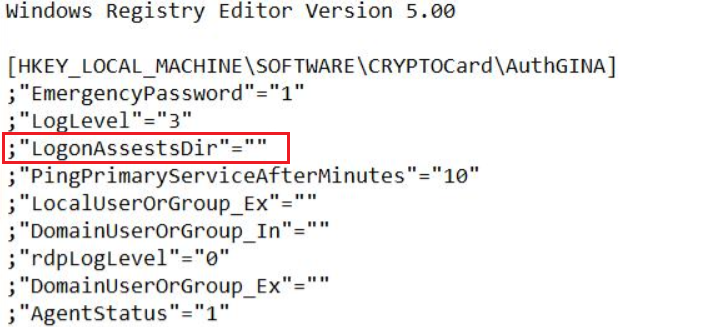Customizing SafeNet Desktop Logon Application
Configuration Management
The Logging tab in the SafeNet Windows Logon Agent Manager (management console) depicts the logging level and specifies the log file location.
If you change the log level under Logging Level, for example, 3 to 4, then you need to restart the VSCEnrollment service. After the update, the same log level applies on both SafeNet Desktop Logon and the VSCEnrollment service.
Customizing SafeNet Desktop Logon Application
The administrators can customize the SafeNet Desktop Logon application images and its language using the files present in the Assets folder (provided in the package). Additionally, if you want to customize the SafeNet Desktop Logon application, you must add the following registry setting to the RegistryConfiguration.reg file located in the SCCM-Deployment folder at HKEY_LOCAL_MACHINE\SOFTWARE\CRYPTOCard\AuthGINA.
“LogonAssetsDir”= “<Assets folder path>”

In this release, the agent deployment is tested with Microsoft Endpoint Configuration Manager version 2203.
This section explains the customization steps required on the machine where SafeNet Desktop Logon application is configured. To achieve this for several machines, the admin needs to push the updated folder using either SCCM, GPO, or Intune and update the RegistryConfiguration.reg file at HKEY_LOCAL_MACHINE\SOFTWARE\CRYPTOCard\AuthGINA.
The Assets folder contains the following two files:
The Assets folder must always be accessible to the user for whom the Passwordless Windows Logon is deployed. Also, it must contain both the files (images and local) as is.
If you use a different Assets folder path than the default, ensure that you enter its path in the LogonAssetsDir registry setting at HKEY_LOCAL_MACHINE\SOFTWARE\CRYPTOCard\AuthGINA.
Customizing the Images
The images in the Assets folder can be customized according to your requirements. This section explains the steps to replace the existing image with the required one.
Prerequisite
Ensure that the custom image file matches the size (width and height) as mentioned in the following table:
| Image (in .png format) | Width (in pixels) | Height (in pixels) |
|---|---|---|
| icon | 256 | 256 |
| Logo | 327 | 108 |
| logo-256 | 256 | 256 |
| oops | 88 | 57 |
| success | 34 | 25 |
| tutorial | 180 | 105 |

Below is an example to customize the SafeNet Desktop Logon enrollment experience.
Perform the following steps to customize the existing logo-256.png:
-
Rename the custom icon file to logo-256.png (in png format).
-
Open Windows Explorer and navigate to <InstallationDirectory>\Assets\images.
-
Replace the existing logo-256.png image file with the custom logo-256.png.
The logo-256 image on the notification page will be updated successfully.
Also, to update the other images present in the folder (for example, Logo, success, etc.), follow the same procedure as mentioned above.
Customizing the Language file
Perform the following steps to change the text strings that appear on the SafeNet Desktop Logon application to a different language:
-
Open Windows Explorer and navigate to <InstallationDirectory>\Assets\local.
This folder contains the language files for Passwordless Windows Logon. These language files are JSON files that can be edited in any text editor. Each JSON file contains the same list of key-value pairs.
-
Open the required language file and change the text string for the key.
-
Save the file.
The text strings on the notification page will be updated successfully.
-
To test the solution, refer to the steps mentioned here.
-
If you face any problem with the passwordless configuration, refer to the troubleshooting section.

